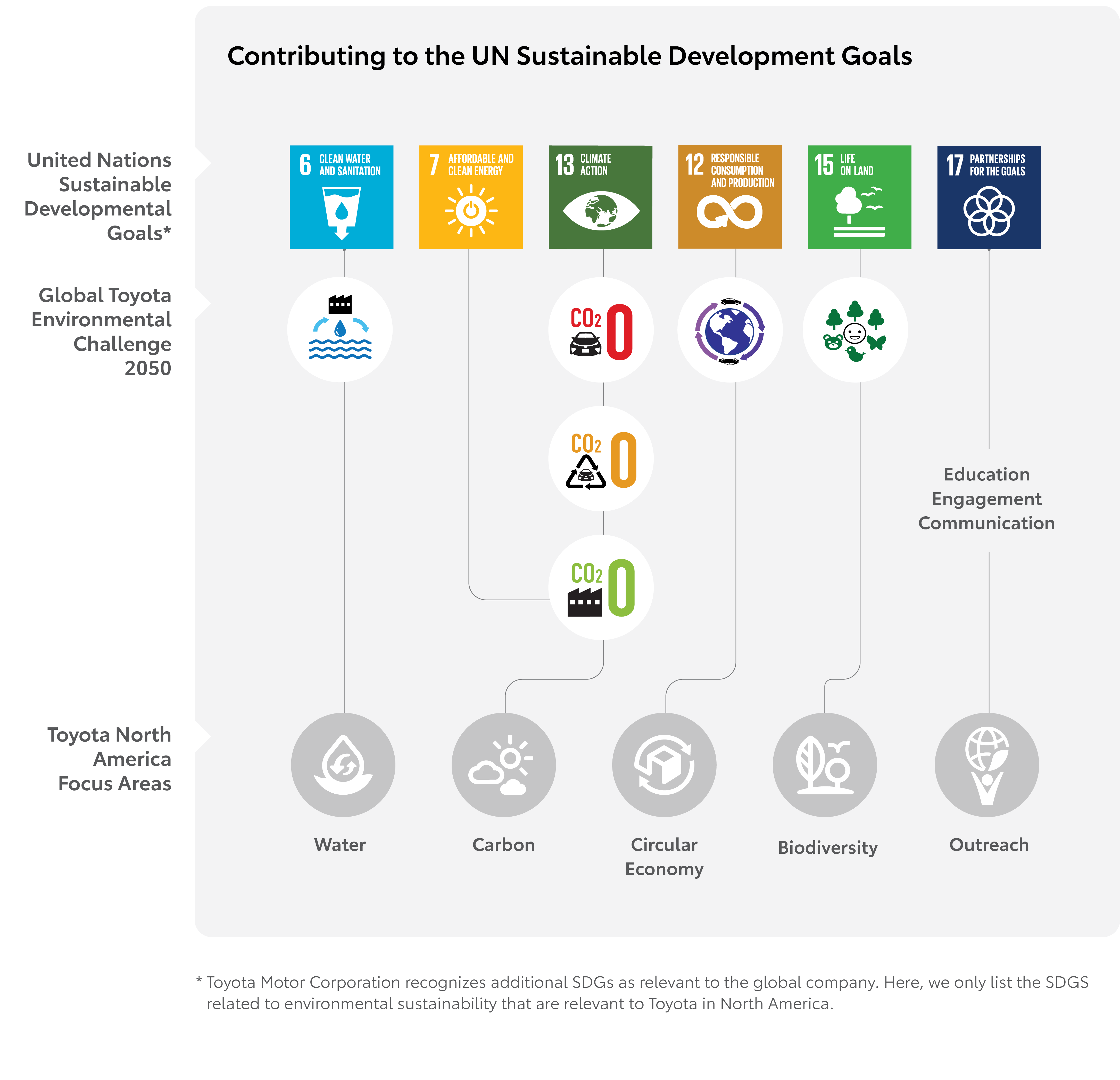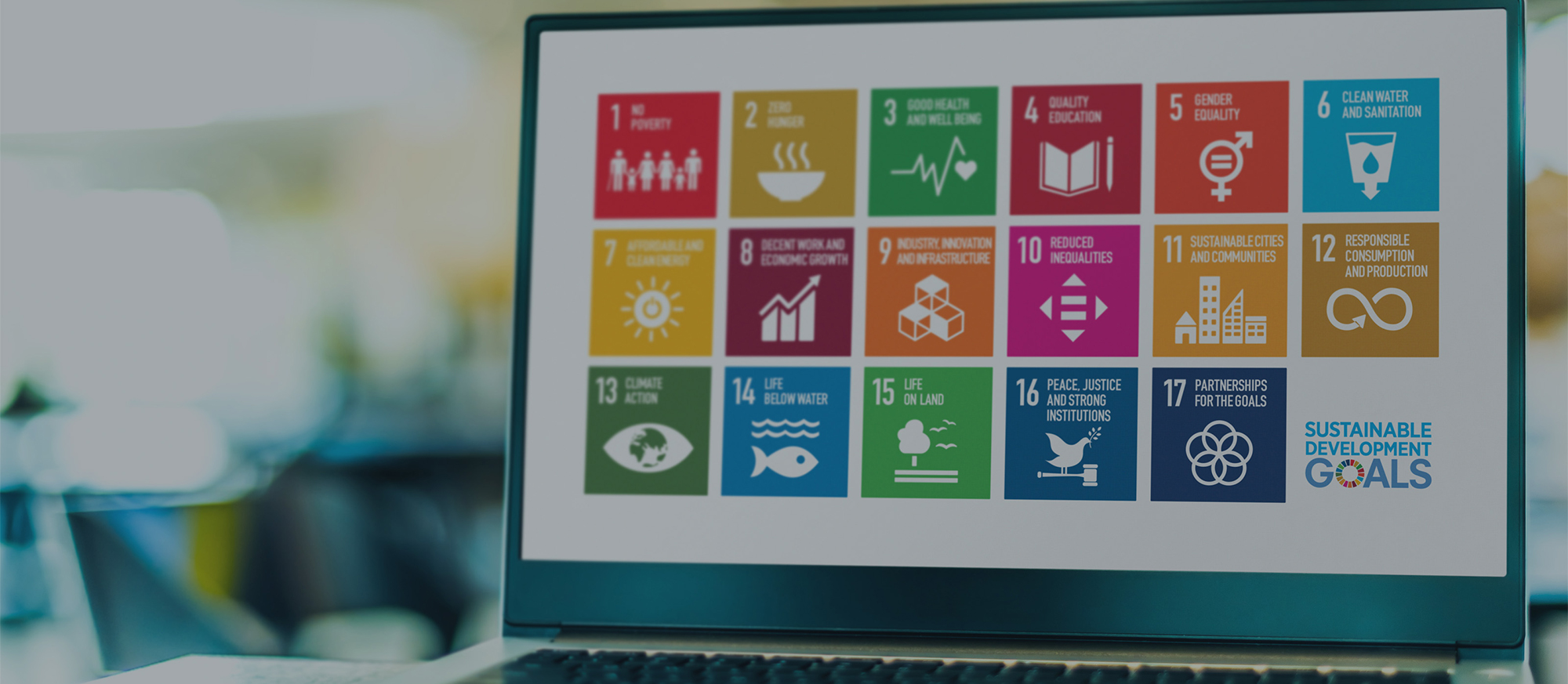In September 2015, the United Nations (UN) adopted the 2030 Agenda, a 15-year plan that aims to end poverty, protect the planet and improve the lives of everyone, everywhere. The cornerstone of the 2030 Agenda is the Sustainable Development Goals (SDGs), a set of 17 global goals with 169 targets that run from 2016 through 2030.
At Toyota, the company supports the fundamental mission of the SDGs – to make the world better, safer and healthier. Toyota’s response to the UN SDGs, particularly those addressing environmental issues, is centered around the six far-reaching challenges within the Toyota Environmental Challenge 2050 (Challenge 2050). Each major region has developed strategies and targets to help the company strive to achieve these challenges.
At Toyota in North America, our activities supporting both Challenge 2050 and the SDGs are organized around our environmental sustainability focus areas of Carbon, Circular Economy, Water and Biodiversity. Our long-term strategies in each of these focus areas, supported by outreach activities, show the steps we’re taking to help address the world’s pressing environmental problems and become part of the solution.
Achieving these goals takes careful planning. And it takes time. We remain committed to acting. Our North American team members are on board, and we are collaborating with suppliers, dealers and other partners. Together, we are ready to make great things happen on our journey towards a more sustainable future.
To find out more about the 17 UN SDGs, visit the UN’s Sustainable Development Goals website.

Carbon
SDG 7: Ensure Access to Affordable, Reliable, Sustainable and Modern Energy for All
Increasing renewable energy capacity and access are crucial to reducing greenhouse gas emissions. Toyota uses energy to power our manufacturing plants, distribution centers and offices. Our suppliers and dealers also use energy to power their facilities. Promoting efficient energy use and renewable energy sourcing are key components of Toyota’s Carbon strategy in North America.
| SDG 7: Affordable & Clean Energy | Toyota North America's Contributions |
|---|---|
| Target 7.2 Increase substantially the share of renewable energy in the global energy mix | See On Our Way to 100% Renewable Electricity for information on our onsite solar arrays and offsite virtual power purchase agreements that together are increasing our use of renewable electricity.
Through TMNA’s Green Supplier Requirements, suppliers are required to pursue opportunities to reduce energy use and CO2 emissions and consider renewable energy options.
Through our Dealership Environmental Excellence Program (D.E.E.P.), we encourage dealerships to reduce energy use and purchase electricity from renewable sources. |
| Target 7.3 By 2030, double the global rate of improvement in energy efficiency | For information on vehicle fuel efficiency and energy efficiency in operations, see the Environmental Metrics Table, sections on Vehicle Fuel Efficiency and Energy. |
SDG 13: Take Urgent Action to Combat Climate Change and its Impacts
TMNA acknowledges climate change as a priority management issue and supports the goals of the Paris Agreement to keep warming well below 2°C and to pursue efforts to limit warming to 1.5°C.
We are working towards reducing CO₂ emissions from new vehicles by offering a range of low emission vehicles, including fuel cell (FCEV), hybrid (HEV), plug-in hybrid (PHEV) and battery electric (BEV) vehicles, which allows us to use our limited battery resources to put more cars on the road that reduce carbon emissions in the short term. We are also working towards reducing GHG emissions from our facilities and transportation activities and increasing our use of renewable energy. And we are working with suppliers and dealers to communicate our goals and help them find ways to reduce their carbon footprint.
| SDG 13: Climate Action | Toyota North America's Contributions |
|---|---|
| Target 13.3 Improve education, awareness-raising and human and institutional capacity on climate change mitigation, adaptation, impact reduction and early warning | See Our Path to Carbon Neutrality to learn about what we’re doing to reduce carbon emissions across the vehicle life cycle.
For information on performance as of the end of FY2025, see the Toyota North American Environmental Sustainability Report, sections on Carbon Targets and GHG Emissions Data.
See our story here about how behavioral science can unlock more carbon reductions from electric vehicles. |
Water
SDG 6: Clean Water and Sanitation
Water is a precious and finite resource that is critical to the survival of people and the planet. But water scarcity is a growing problem in many parts of the world. Some of Toyota's North American sites are in water-stressed areas, and our larger assembly plants use significant volumes of water during vehicle production, particularly in the painting process.
In North America, we are moving beyond an onsite water management approach to one of site and watershed water stewardship. We are committed to engaging in and supporting efforts that reduce and recycle water used in our facilities, protect water bodies, invest in education and awareness, and share best practices with others.
| SDG 6: Clean Water & Sanitation | Toyota North America's Contributions |
|---|---|
| Target 6.4 By 2030, substantially increase water-use efficiency across all sectors and ensure sustainable withdrawals and supply of freshwater to address water scarcity and substantially reduce the number of people suffering from water scarcity | For information on our approach to water stewardship as well as our targets and performance, see the Water chapter of the 2025 Toyota North American Environmental Sustainability Report.
For information on water efficiency in our North American operations, see the Environmental Metrics Table, section on Water. |
| Target 6.6 By 2020, protect and restore water-related ecosystems, including mountains, forests, wetlands, rivers, aquifers and lakes | For information on how we are helping to restore water flows in the Colorado River Delta, see our story here. |
Circular Economy
SDG 12: Responsible Consumption and Production
Economic growth and development require the production of goods and services that improve quality of life. But the rapid increase in global consumption of materials has come at a cost to the environment. Sustainable production and consumption patterns are needed to minimize natural resource depletion and the use of toxic materials as well as reduce waste and pollutants.
Here in North America, to help promote a circular economy and help avoid both depletion of natural resources and environmental pollution from increasing amounts of waste, we focus on increasing reuse and recycling, reducing waste and enhancing our use of sustainable raw materials.
| SDG 12: Responsible Consumption & Production | Toyota North America's Contributions |
|---|---|
| Target 12.2 By 2030, achieve the sustainable management and efficient use of natural resources | See the Circular Economy chapter of the 2025 Toyota North American Environmental Sustainability Report, section on Battery Recycling for information on how we are working with partners with the aim of creating a closed-loop ecosystem for electrified vehicle batteries. |
| Target 12.4 By 2020, achieve the environmentally sound management of chemicals and all wastes throughout their life cycle, in accordance with agreed international frameworks, and significantly reduce their release to air, water and soil in order to minimize their adverse impacts on human health and the environment | See the Circular Economy chapter of the 2025 Toyota North American Environmental Sustainability Report, sections on Chemical Management and Waste, for information on how we are working to enhance the chemical management capabilities of the North American supply chain and reduce waste from our operations. |
| Target 12.5 By 2030, substantially reduce waste generation through prevention, reduction, recycling and reuse | For information on waste reduction activities and recycling, see the Circular Economy chapter of the 2025 Toyota North American Environmental Sustainability Report, section on Waste. |
| Target 12.6 Encourage companies, especially large and transnational companies, to adopt sustainable practices and to integrate sustainability information into their reporting cycle | Toyota North America has been publishing an Environmental Sustainability Report for two decades. See the 2025 report here.
For information on our environmental sustainability strategy, goals and targets, focus areas and more, see the Environmental Sustainability section of our website. |
Biodiversity
SDG 15: Life on Land
Halting biodiversity loss has become a critical endeavor as many species slide towards extinction. We believe business has a role to play in reversing nature loss and protecting biodiversity.
Across North America, we are focusing on avoidance of negative impacts on threatened or protected species and restoration of degraded habitat. Our focused approach to this involves working with stakeholders, including employees, communities and nonprofit organizations, on biodiversity projects on our sites and in our communities.
| SDG 15: Life on Land | Toyota North America's Contributions |
|---|---|
| Target 15.1 By 2020, ensure the conservation, restoration and sustainable use of terrestrial and inland freshwater ecosystems and their services, in particular forests, wetlands, mountains and drylands, in line with obligations under international agreements | For information on how we are helping to restore water flows in the Colorado River Delta, see our story here. |
| Target 15.5 Take urgent and significant action to reduce the degradation of natural habitats, halt the loss of biodiversity and, by 2020, protect and prevent the extinction of threatened species | For information on our efforts to protect biodiversity, see the Biodiversity chapter of the 2025 Toyota North American Environmental Sustainability Report.
For information on our target to develop and enhance 26,000 acres of pollinator habitat to support pollinator species, see Toyota’s Blossoming Commitment: Nurturing Biodiversity Through Bees and Butterflies. |
Outreach
SDG 17: Partnerships for the Goals
We recognize that no single entity can achieve the SDGs in isolation. These are shared problems that require a shared response.
The Toyota Environmental Challenge 2050 seeks to create positive impact, which can only be achieved by collaborating with our stakeholders. Through the power of collaboration, we hope to create lasting outcomes on a macro scale that will help us build a more sustainable future.
In North America, Toyota supports local, national and regional community projects that align with our environmental sustainability focus areas of Carbon, Circular Economy, Water and Biodiversity. By concentrating our support on organizations that address challenges in these four core areas, we are building on our environmental commitment beyond minimizing negative impacts and helping to promote positive environmental change across the North American region. We share our know-how and collaborate so that we can build more than great cars – we are building a better tomorrow by harnessing the power of collective action.
| SDG 17: Partnerships for the Goals | Toyota North America's Contributions |
|---|---|
| Target 17.17 Encourage and promote effective public, public-private and civil society partnerships, building on the experience and resourcing strategies of partnerships data, monitoring and accountability | Examples of Civil Society Partnerships:
We partner with the National Environmental Education Foundation (NEEF) and Pollinator Partnership to enhance pollinator habitat acreage.
We collaborate with The Nature Conservancy to help restore water flows in the Colorado River Delta. |




